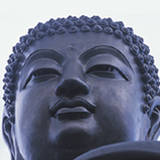 The precise origins of Mahayana Buddhism are something of a mystery. The historical record shows it emerging as a separate school from Theravada during the 1st century BCE. However, it most likely had been developing gradually for a long time before that.
The precise origins of Mahayana Buddhism are something of a mystery. The historical record shows it emerging as a separate school from Theravada during the 1st century BCE. However, it most likely had been developing gradually for a long time before that.
Some scholars have suggested that Mahayana is an offspring of Mahasanghika, a now-extinct Buddhist sect formed about 320 BCE. Mahasanghika developed the idea of the transcendent nature of a Buddha, the ideal of the bodhisattva, and the doctrine of shunyata, or “emptiness.”
A Gradual Beginning
However the two schools originated, it’s fair to say that both Theravada and Mahayana developed from the earliest schools of Buddhism. Historian Heinrich Dumoulin wrote that “Traces of Mahayana teachings appear already in the oldest Buddhist scriptures. Contemporary scholarship is inclined to view the transition of Mahayana as a gradual process hardly noticed by people at the time.” [Dumoulin, Zen Buddhism: A History, Vol. 1, India and China (Macmillan, 1994), p. 28]
Some time in the 1st century BCE, the name Mahayana, or “great vehicle,” was established to distinguish this divergent school from Theravada. Theravada was derided as “Hinayana,” or the “lesser vehicle.” The names point to the distinction between Theravada’s emphasis on individual enlightenment and the Mahayana ideal of the enlightenment of all beings. The name “Hinayana” is generally considered to be a pejorative.
Over the years, Mahayana subdivided into more schools with divergent practices and doctrines. These spread from India to China and Tibet, then to Korea and Japan. Today Mahayana is the dominant form of Buddhism in those countries.
By Barbara O’Brien
Source : buddhism.about.com




